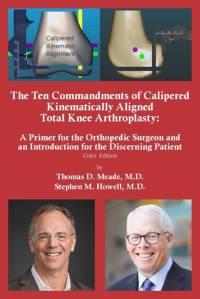Om The Ten Commandments of Calipered Kinematically Aligned Total Knee Arthroplasty
The modern field of total knee arthroplasty began over 50 years ago in the 1970s when the FDA approved cement for implant fixation, and durable plastic that replaced the meniscus became available. Simultaneously, alignment evolved into two opposing and contentious philosophies, the anatomic approach (forefather of kinematic alignment, ) and the 'cookie-cutter' or mechanical alignment. In 2006, the concept of personalized surgery initiated a paradigm shift away from the philosophy of mechanical alignment to calipered kinematic alignment total knee replacement. Dr. Howell, a professor of biomedical engineering and a sports medicine surgeon, developed the kinematic alignment technique. To perform the surgery, he created the first commercially made patient-specific guides designed to assist the surgeon in setting the components coincident to the patient's pre-arthritic joint lines, which is the kinematic alignment target.In 2007, early adopters' clinical experience, particularly Dr. Meade, persuaded over 300 surgeons to perform more than 20,000 kinematically aligned total knee replacements by 2011. Between 2011 and 2020, many worldwide studies reported that kinematic alignment improves patient satisfaction, function, ease of recovery, soft tissue balance, flexion, and joint-line and limb alignment compared with mechanical alignment. It is a winning approach.This primer uses the familiar concept of the Ten Commandments and selects ten topics for the surgeon to follow. The success of kinematic alignment requires caliper measurements of bone resections and intraoperative recording of verification steps. These recommendations reduce the risk of complications, a topic of great interest to the patient! Patients that research options in total knee replacement surgery will come across the kinematic and mechanical alignment philosophies. The mechanical alignment technique is a 'cookie-cutter' approach that places the components the same way in everybody regardless of their legs' shape. Because the method changes the patient's joint lines, the healthy ligaments are released, making the replaced knee feel unnatural. Kinematic alignment restores the patient's knee alignment before arthritis developed and preserves healthy ligaments, promoting patient satisfaction and high function.We hope this primer is useful for those investigating knee replacement surgery. Those who chose kinematic alignment, ask your surgeon whether they use the caliper and intraoperative verifications to position your new knee optimally!
Visa mer

